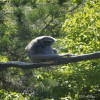Hylobates muelleri
The Mueller's gibbon has a head and body length that ranges from 17 to 25 inches, and a weight that ranges from 17-1/2 to 28-1/2 pounds. Females are the same size as males. General coloration is a blue-gray, with the cap and chest darker. Many of them are almost white at birth, and attain final coloration at 2 to 4 years. The hair is dense. Hylobates means “Dweller in the trees”, and gibbons fully justify the name. Movement is primarily by brachiation, in which the arms are extended above the head to suspend and propel the body. Most traveling is by swinging from branch to branch through the trees. The hands are used as hooks, not grasping the limbs. When walking on the ground or on a limb the arms are held high for balance. Gibbons can leap from branch to branch for 30 feet or more. They are primarily diurnal and exclusively arboreal. Gibbons generally show preferences for small, scattered sources of pulpy fruit, which brings them into competition more with birds and squirrels than with other primates. They are monogamous, and an adult pair and their offspring occupy a small, stable home range, which is defended. Grooming is the most important social behavior. Play, centered on the infant, is the next most common.

